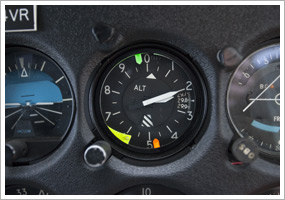| The following stories from the April 29, 2011, edition of AOPA ePilot were provided to AOPA members who expressed an interest in the particular subject areas. Any AOPA member can receive information tailored to their areas of interest by updating their preferences online |
training tipsLooking out below Wait a minute—that’s not how the familiar mnemonic goes. It should be, “When flying from a high to a low, look out below.” The second adage is more familiar, but both are true, and both offer ways to learn the complex behavior of a very simple cockpit instrument: the altimeter. What’s also true is that questions about altimeters routinely trip up pilots on knowledge tests, during checkrides, and in flight. Suppose you flew yesterday, and today a low is moving in. If your aircraft has remained parked since you flew it, will its altimeter read higher or lower today? The altimeter will “interpret” the lower pressure as a climb, and a higher altitude will be the resulting indication. “A decrease in pressure causes the altimeter to indicate an increase in altitude, and an increase in pressure causes the altimeter to indicate a decrease in altitude,” explains Chapter 7 of the Pilot’s Handbook of Aeronautical Knowledge. “Accordingly, if the aircraft is sitting on the ground with a pressure level of 29.98 ”Hg and the pressure level changes to 29.68 ”Hg, the altimeter would show an increase of approximately 300 feet in altitude. This pressure change is most noticeable when the aircraft is left parked overnight. As the pressure falls, the altimeter interprets this as a climb.” The “hot to cold” variation on “look out below” also appears in the chapter. It teaches that temperature variations also can cause an altimeter to mislead. “When the air is warmer than standard, you are higher than your altimeter indicates. Subsequently, when the air is colder than standard you are lower than indicated. It is the magnitude of this ‘difference’ that determines the magnitude of the error,” explains the Aeronautical Information Manual’s discussion of altimeter setting procedures. Update your altimeter setting frequently in flight, using the nearest station, as specified by regulation. Remember that an inch of barometric pressure represents about 1,000 feet of altitude, and that if a properly set altimeter indicates more than 75 feet off compared to a known field elevation, it should be examined by a technician. Altimetry is challenging to master in its details, and deserves periodic review by pilots of all experience. training productsColor E6-B from ASAThe trusty E6-B gets a colorful makeover in a new version produced by ASA. The aluminum slide-rule computer’s circular side uses black for the rate arrow and units to be calculated; red for weight and volume; and blue for distance, time, and temperature scales. Colors on the wind side are used to identify wind variation. The unit will sell for $34.95 beginning in May. Orders may be placed online. Note: Products listed have not been evaluated by ePilot editors unless otherwise noted. AOPA assumes no responsibility for products or services listed or for claims or actions by manufacturers or vendors. final exam
Question: Recently on a cross-country flight I tuned in a VOR and when I turned up the volume there was weather information being broadcast along with the Morse code. I also noticed an H in the upper right corner of the communications box for that VOR. What does that mean, and what was I hearing on the VOR?
Answer: You were listening to the hazardous in-flight weather advisory service (HIWAS). This is a continuous broadcast of in-flight weather advisories that includes sigmets, convective sigmets, center weather advisories, airmets, aviation weather warnings, and urgent pireps. HIWAS is an additional resource for keeping track of hazardous weather information. Check your IFR en route low-altitude charts and VFR sectional charts for HIWAS availability in your area. For more on weather services and sources see AOPA’s Handbook for Pilots .
Got a question for our technical services staff? E-mail [email protected] or call the Pilot Information Center, 800/872-2672. Don’t forget the online archive of “Final Exam” questions and answers, searchable by keyword or topic. |
 An old saying that every pilot should know states: “From hot to cold, look out below.”
An old saying that every pilot should know states: “From hot to cold, look out below.”

